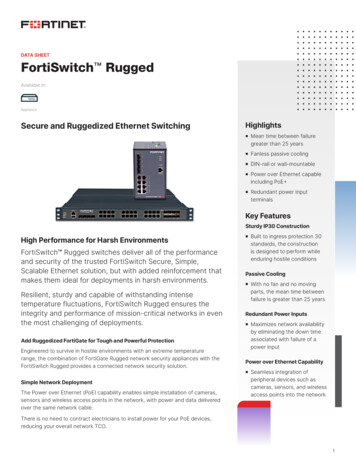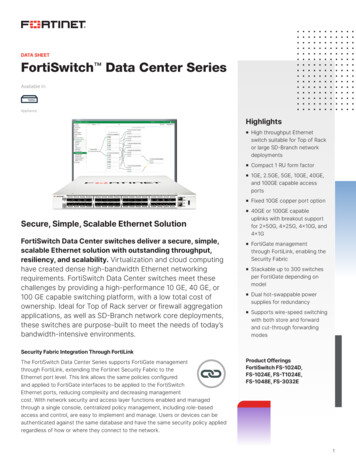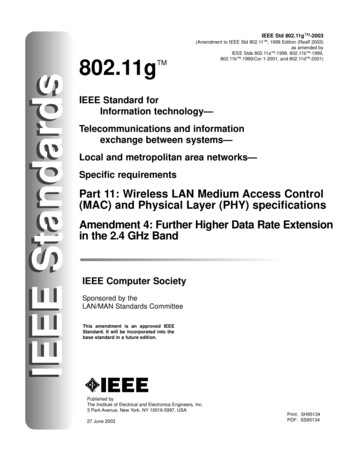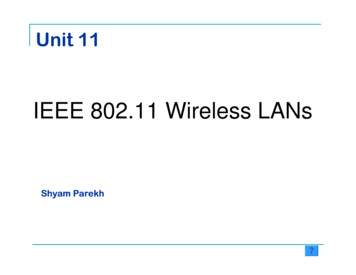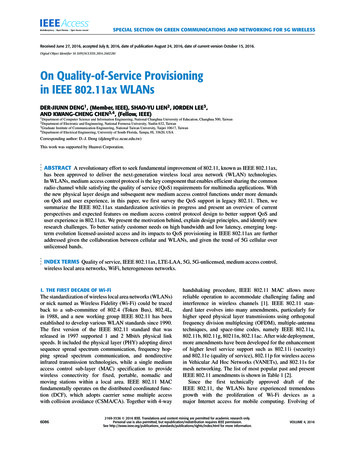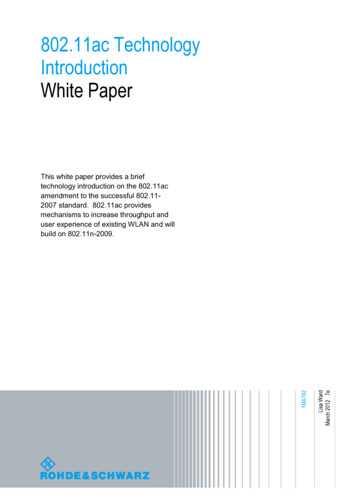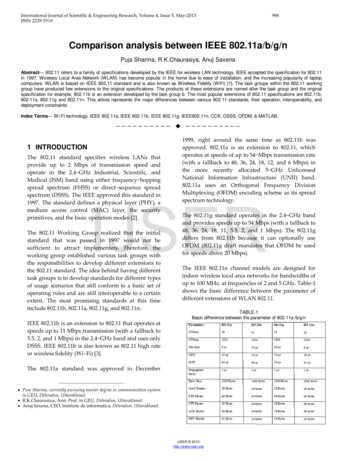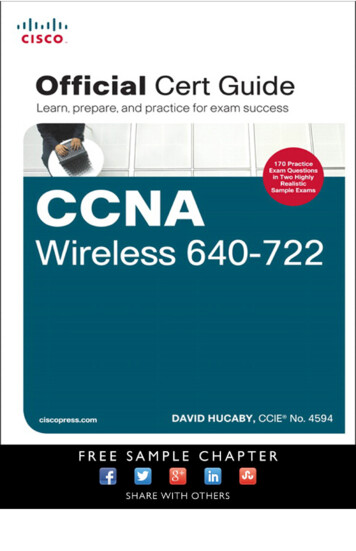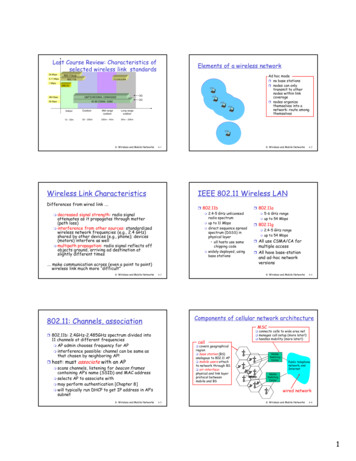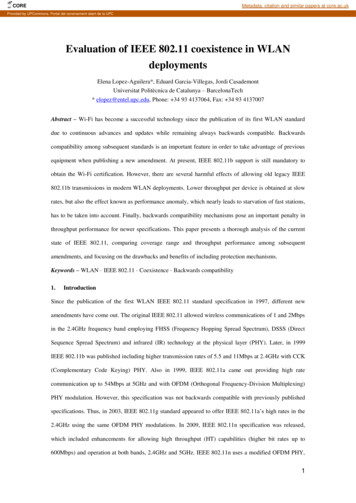
Transcription
COREMetadata, citation and similar papers at core.ac.ukProvided by UPCommons. Portal del coneixement obert de la UPCEvaluation of IEEE 802.11 coexistence in WLANdeploymentsElena Lopez-Aguilera*, Eduard Garcia-Villegas, Jordi CasademontUniversitat Politècnica de Catalunya – BarcelonaTech* elopez@entel.upc.edu, Phone: 34 93 4137064, Fax: 34 93 4137007Abstract – Wi-Fi has become a successful technology since the publication of its first WLAN standarddue to continuous advances and updates while remaining always backwards compatible. Backwardscompatibility among subsequent standards is an important feature in order to take advantage of previousequipment when publishing a new amendment. At present, IEEE 802.11b support is still mandatory toobtain the Wi-Fi certification. However, there are several harmful effects of allowing old legacy IEEE802.11b transmissions in modern WLAN deployments. Lower throughput per device is obtained at slowrates, but also the effect known as performance anomaly, which nearly leads to starvation of fast stations,has to be taken into account. Finally, backwards compatibility mechanisms pose an important penalty inthroughput performance for newer specifications. This paper presents a thorough analysis of the currentstate of IEEE 802.11, comparing coverage range and throughput performance among subsequentamendments, and focusing on the drawbacks and benefits of including protection mechanisms.Keywords – WLAN · IEEE 802.11 · Coexistence · Backwards compatibility1.IntroductionSince the publication of the first WLAN IEEE 802.11 standard specification in 1997, different newamendments have come out. The original IEEE 802.11 allowed wireless communications of 1 and 2Mbpsin the 2.4GHz frequency band employing FHSS (Frequency Hopping Spread Spectrum), DSSS (DirectSequence Spread Spectrum) and infrared (IR) technology at the physical layer (PHY). Later, in 1999IEEE 802.11b was published including higher transmission rates of 5.5 and 11Mbps at 2.4GHz with CCK(Complementary Code Keying) PHY. Also in 1999, IEEE 802.11a came out providing high ratecommunication up to 54Mbps at 5GHz and with OFDM (Orthogonal Frequency-Division Multiplexing)PHY modulation. However, this specification was not backwards compatible with previously publishedspecifications. Thus, in 2003, IEEE 802.11g standard appeared to offer IEEE 802.11a’s high rates in the2.4GHz using the same OFDM PHY modulations. In 2009, IEEE 802.11n specification was released,which included enhancements for allowing high throughput (HT) capabilities (higher bit rates up to600Mbps) and operation at both bands, 2.4GHz and 5GHz. IEEE 802.11n uses a modified OFDM PHY,1
two different channel bandwidths (20 and 40MHz), frame aggregation mechanisms and improved FEC(Forward Error Correction). Nevertheless, the most important feature is that it enables spatialmultiplexing with up to 4 spatial streams using MIMO (Multi-Input Multi-Output) techniques, thusleading to HT performance. The standard document IEEE 802.11-2012 [1] published in 2012 includes areview of all these previous amendments. Moreover, other IEEE 802.11 specifications (cf. Table 1) cameout in the last years that provide additional features to the IEEE 802.11 Medium Access Control (MAC)protocol. Also, the IEEE 802.11ac amendment presents enhancements for very high throughput (VHT)operation only in the 5GHz band through channel bandwidth extension (20, 40, 80 and 160MHz), highdensity modulation, improved FEC, frame aggregation, higher number of spatial streams (up to 8) anddownlink MU-MIMO (multiuser MIMO) to transmit different streams to several client stationssimultaneously. IEEE 802.11ac represents the latest advance in Wi-Fi technology and the successor ofIEEE 802.11n. The higher data rates offered by IEEE 802.11ac allow video delivery of higher quality inmobile terminals and also are suitable for high-density environments with high number of clients peraccess point (AP). Future IEEE 802.11ax standard (expected in 2019) aims at increasing 4 timesthroughput performance, and thus, at improving efficiency in dense environments.Wi-Fi has become a successful technology since the publication of its first WLAN standard due to thecontinuous advances and updates while remaining always backwards compatible. On the other hand,IEEE 802.11n/ac have become very popular since their certification by the Wi-Fi Alliance. Thus,previous amendments have lost influence in WLAN penetration in front of IEEE 802.11n/ac: the latterhave increased their presence with respect to IEEE 802.11g, whereas IEEE 802.11b and IEEE 802.11apenetration remains very residual [2]–[3]. Backwards compatibility among subsequent standards is animportant feature in order to take advantage of previous equipment when publishing a new amendment.However, there are several harmful effects of allowing old legacy IEEE 802.11b transmissions in modernWi-Fi deployments. First, we have to take into account the lower user throughput obtained at slow rates.Second, the effect known as the performance anomaly has to be considered, which arises in networkswith stations operating at different physical bit rates, and can lead to fast stations being nearly starvedwhereas slow clients practically do not perceive any rate decrease [4]. This effect has been later reducedwith the introduction of frame aggregation mechanisms, Block Acknowledgement frames and the usageof Transmission Opportunity (TXOP) control in IEEE 802.11n/ac amendments. And third, there is theneed for backwards compatibility mechanisms to allow coexistence between new and previously defined2
amendments; these mechanisms pose an important penalty in throughput performance for newerspecifications. At present, IEEE 802.11b support is still mandatory to obtain the Wi-Fi certification. Inthis regard, some chipset manufacturers are pushing to remove such requirement due to the unnecessarycomplexity of implementing the old modulation and coding scheme set. However, the pressure of animportant sector of that industry to deprecate IEEE 802.11b, a question being considered by the Wi-FiAlliance and the IEEE P802.11 WG, is facing the opposition of those who defend that IEEE 802.11b isstill useful today in M2M (Machine-to-Machine) and IoT (Internet of Things) applications due to thelower costs of a simpler technology. With this regard, IEEE P802.11 WG is working on forthcomingIEEE 802.11ah amendment in order to enable the IoT application use case.Different studies in the literature have evaluated the influence of backwards compatibility mechanisms inIEEE 802.11g performance in presence of legacy IEEE 802.11b devices [5]; in this way, reference [6]points out the IEEE 802.11g degradation, as compared to IEEE 802.11a, which does not include suchmechanisms. Reference [7] presents IEEE 802.11n performance penalty taking into account differentoperating modes and transmission rates; however, this study has been carried out with an IEEE 802.11npre-standard version (Draft 4.0, 2008) and the higher transmission rates have not been considered.Moreover, reference [8] studies interoperability between IEEE 802.11n and IEEE 802.11a/g in terms ofsynchronization issues due to the utilization of a compatible preamble, but performance degradation is notincluded in the evaluation. With regard to IEEE 802.11ac amendment, comparison with IEEE 802.11nhas been exposed in [9], but it only presents the influence of frame aggregation mechanisms in throughputperformance. On the other hand, reference [10] provides measurement results in a typical office building.Other published papers concentrate in the introduction of larger channel width and MU-MIMO [11], thecomparison of MU-MIMO and single-user MIMO (SU-MIMO) [12], the impact of channel width andMU-MIMO in efficiency and interference characterization [13], and the analysis of the inefficiency andunfairness when channels of variable bandwidth coexist [14]. Thus, a thorough analysis of the currentstate of IEEE 802.11 specification, focusing on the drawbacks and benefits of including protectionmechanisms to allow backwards compatibility among subsequent amendments, has not been yetpublished in the literature. To the best of our knowledge, this is the first paper providing such study.Section 2 shows a comparison of IEEE 802.11 standards’ capabilities in terms of coverage andthroughput issues. Next, Section 3 evaluates the effects of guaranteeing coexistence of IEEE 802.113
specifications. Finally, Section 4 concludes the paper and presents some final recommendations for thedeployment of future Wi-Fi networks.AmendmentIEEE 802.11 (1997)IEEE 802.11b (1999)IEEE 802.11a (1999)IEEE 802.11g (2003)IEEE 802.11h (2003)IEEE 802.11i (2004)IEEE 802.11e (2005)IEEE 802.11r (2008)IEEE 802.11k (2008)IEEE 802.11n (2009)IEEE 802.11w (2009)IEEE 802.11z (2010)IEEE 802.11p (2010)IEEE 802.11v (2011)IEEE 802.11u (2011)IEEE 802.11s (2011)IEEE 802.11ae (2012)IEEE 802.11ad (2012)IEEE 802.11aa (2012)IEEE 802.11af (2013)IEEE 802.11ac (2013)Description1 and 2Mbps at 2.4GHz with FHSS, DSSS and IR PHY1, 2, 5.5 and 11Mbps at 2.4GHz with CCK PHY6, 9, 12, 18, 24, 36, 48 and 54Mbps at 5GHz and with OFDM PHY6, 9, 12, 18, 24, 36, 48 and 54Mbps at 2.4GHz and with OFDM PHYSpectrum and transmit power management extensions, Dynamic Frequency Selection(DFS) and Power Control (PC) mechanisms, to solve interference problems at 5GHzSecurity enhancements: Temporal Key Integrity Protocol (TKIP) and Counter Mode(CTR) with Cipher-Block Chaining Message Authentication Code (CBC-MAC)Protocol (CCMP) encryption methods and Robust Security Network Association(RSNA) protocol (authentication through 802.1x and Extensible Authentication Protocol(EAP))MAC enhancements for the prioritization of traffic classes through the modification ofMAC parametersDefinition of authentication and association messages in order to complete fast andsecure handoffs between Basic Service SetsRadio Resource Measurements (RRM) of WLANs to facilitate its management andmaintenanceHT capabilities with MIMO (bit rates up to 600Mbps) at 2.4GHz and 5GHzDefinition of protected management frames to increase their security through dataconfidentialityAutomatic set-up of a direct link between client devices while also remaining associatedwith the access pointIntra-vehicle, vehicle to vehicle and vehicle to infrastructure communicationsNetwork management of client devices through the exchange of network informationInterworking with external networks thus enabling information transfer from/to externalnetworks (e.g. 4G networks)Mesh networking: mechanisms to form self-configuring multi-hop networks forbroadcast, multicast and unicast data deliveryMechanisms for prioritization of management framesPHY and MAC modifications for VHT at 60GHzMAC enhancements for robust audio and video streaming while maintaining coexistencewith other types of trafficUtilization of IEEE 802.11 technology within licensed television spectrum, takingadvantage of unused white spacesVHT operation (bit rates up to 7Gbps) at 5GHzTable 1. Description of IEEE 802.11 amendments.2.Comparison of IEEE 802.11 WLAN standards2.1 CoverageThe coverage of an IEEE 802.11 AP is the area surrounding it within which communication with that APis possible. Among the most important factors determining the dimensions of this area, first, we have thecharacteristics of the environment affecting the propagation of waves, the frequency and transmittedpower, which usually depend on local regulations, but also the PHY used. The following two figuresprovide a comparison on the expected cell radius for different technologies in different environments 1.Figure 1 represents received power vs. distance for four channel propagation models at 2.4GHz: TGn(A,B,C) and TGn (D) represent office and open-office environments (A, B and C without line of sight, Dadds line of sight) according to the specifications of the TGn [15], TGah (pico) consists of outdoor pico1In all cases, we assume 20dBm of transmitted power and isotropic antennas.4
cell scenarios (antenna of the AP at rooftop level), and TGah (D2D) represents outdoor device to deviceenvironments [16]. Figure 2 shows the maximum cell radius for different PHY configurations in each ofthe four chosen scenarios. Both the most reliable (i.e. slowest) and the fastest modulations are representedfor each IEEE 802.11 generation (11a/b/g/n/ac), assuming 20MHz channels and one spatial stream forMIMO capable PHYs. Faster modulations and coding schemes have more complex constellations and useless redundancy and, thus, will require a stronger received signal than slow modulations. Therefore,higher modulations are available for shorter distances. The receiver sensitivity used to compute the cellradius shown in Figure 2 is taken from the datasheets of different products available in the market (cf.[17] for a client device, [18] for an AP). Regarding the frequency used, note that transmissions in higherfrequencies (i.e. IEEE 802.11a/ac in 5GHz) undergo higher propagation losses. With coverage in mind,there are other phenomena that should also be considered when designing an IEEE 802.11 WLAN: Obstacles: each wall and floor reduces received power between 10 and 20dB, depending on thebuilding material [19]. Regulations: maximum allowed transmitted power is determined by local regulations and maychange from one country to another and from one frequency band to another. For example, IEEE802.11a/n/ac WLANs are allowed to transmit 23dBm in the UNII 1 and 2, and up to 30dBm inUNII 3 if certain conditions are met. This increased power is intended to compensate for theincreased propagation losses of higher frequencies. Modulation and Coding Scheme (MCS): high order modulations require higher SNIR (Signalto Noise and Interference Ratio) but, paradoxically, they should be used with lower transmittedpower to avoid amplifier distortion due to high peak to average ratios [20]. For example, it isrecommended that the maximum transmitted power for IEEE 802.11n’s MCS 7 is 4-5dB lowerthan for MCS 0. This power reduction is translated into 10 to 40m smaller cell radius (dependingon the channel model). Channel bonding: IEEE 802.11n/ac can bond two or more 20MHz channels to increase thePHY rate. However, since the maximum transmitted power is the same as with 20MHz, thepower density of the signal is decreased along with SNIR when the bandwidth is increased. Thegeneral rule of thumb is that SNIR is reduced 3dB every time the bandwidth is doubled. Thisreduction in SNIR is translated into 5 to 30m smaller radius for 40MHz (depending on thechannel model used), or 15 to 60m in the case of 80MHz.5
Spatial diversity: MIMO technology present in IEEE 802.11n/ac allows spatial multiplexing toincrease rate, but also enables the implementation of spatial diversity techniques, which improvereliability and increase range. Multiple Ratio Combining or Transmitter beamforming, forexample, may improve received signal by 2 to 4dB (i.e. 10-35m of increased range).2.2 User ThroughputDespite the different frequency bands and PHY rates of the subsequent amendments, the MAC operationhas been continually based on Carrier Sense Multiple Access with Collision Avoidance (CSMA/CA)mechanism and works as follows. Before initiating a transmission, a station senses the channel todetermine whether it is busy. If the medium is sensed idle during a period of time called the DistributedInter-frame Space (DIFS), the station is allowed to transmit. If the medium is sensed busy, thetransmission is delayed until the channel is idle again. In this case, a slotted binary exponential backoffinterval is uniformly chosen in [0, CW-1], where CW is the contention window. The backoff timer isdecreased as long as the channel is sensed idle, paused when a transmission is in progress, and resumedwhen the channel is sensed idle again for more than the DIFS. When the backoff timer expires, the stationattempts transmission. After each data frame is successfully received, the receiver transmits anacknowledgment (ACK) frame after a Short Inter-frame Space (SIFS) period. The value of CW is set to itsminimum value, CWmin, in the first transmission attempt and after each successful transmission; increasesin integer powers of 2 at each retransmission, up to a pre-determined value CWmax. MAC protocol hasevolved in the latest amendments (IEEE 802.11n/ac) with the introduction of frame aggregationmechanisms, the employment of Block Acknowledgement frames and the usage of TXOP control.We analyze user throughput for the different amendments. For comparison purposes, our first evaluationscenario consists in a single radio link composed of two stations (a transmitter and a receiver) thatexchange data frames under ideal transmission conditions. Hereafter, the influence of an increasingnumber of stations is shown.The various amendments present differences in the physical layer convergence procedure (PLCP)preamble and header duration, as can be observed from Table 2. IEEE 802.11b includes a long and a shortpreamble. On the other hand, IEEE 802.11n presents different transmission modes (Non-HT, HT Mixedand HT Greenfield) and thus three preamble types (cf. Figure 3): Non-HT preamble: it employs PLCP preamble/header used by legacy IEEE 802.11b, IEEE802.11g or IEEE 802.11a. Support is mandatory.6
HT Mixed Format preamble: it consists of an HT preamble preceded by an IEEE 802.11a/g nonHT preamble. Support is mandatory. HT Greenfield Format preamble (purely HT preamble). Support is optional.IEEE 802.11ac also offers non-VHT transmission modes (Non-HT, HT Mixed, HT Greenfield) and VHTmode. Preamble types of the non-VHT modes correspond to those shown for IEEE 802.11n (cf. Figure 3).VHT preamble is exposed in Figure 4 and its support is mandatory.The throughput computation, S, in Mbps follows next expression:S Ldata 8Tmessage(1)Tmessage DIFS TBackoff Tdata SIFS TACK(2)Ldata consists in the payload size of data frames in Bytes. DIFS and SIFS are given in Table 2, consistsin the propagation delay, which can be neglected at typical WLAN distances, TACK corresponds to theduration of an ACK frame and Tdata represents the transmission time of a data frame, which dependsmainly on the size of the payload and the PHY rate. Under ideal transmission conditions we considerTBackoff is, on average, CWmin/2 times the slot time. Times are expressed in µs.Tdata and TACK computation depends on the IEEE 802.11 amendment used in the transmission.Thus, for IEEE 802.11b Tdata follows next expression:Tdata T preamble/ header Standard, rateIEEE 802.11b,1MbpsIEEE 802.11b, 2,5.5, 11MbpsIEEE 802.11aIEEE 802.11gIEEE 802.11nHT Mixed,5GHzIEEE 802.11nHT Greenfield,5GHzIEEE 802.11nHT Mixed,2.4GHzIEEE 802.11nHT Greenfield,2.4GHzIEEE 802.11acVHT Lheader Ldata 8(3)rPLCP x1023Slot T preamble/header 16µs 02310239µs9µs9µs24µs variable*34µs16µs1510239µsNon-HT preamble/header 16µs variable*28µs10µs1510239µs24µs variable*28µs10µs1510239µs36µs variable*34µs16µs1510239µs* Variable value that depends on the number of spatial streams (cf. Table 3)Table 2. Values for PHY and MAC parameters per amendment.7
where r corresponds to the PHY rate (in Mbps), Tpreamble/header is given in Table 2 and Lheader is 36Byteslong (including MAC and LLC headers).For IEEE 802.11a Tdata is as follows: 22 Lheader Ldata 8 Tdata Tpreamble/ header 4 4r (4)For IEEE 802.11g Tdata is: 22 Lheader L data 8 Tdata Tpreamble/ header 4 TSignalExtension4r (5)where TSignalExtension is 6µs.With regard to IEEE 802.11n, Tdata and TACK computation depends on the transmission mode (Non-HT,HT Mixed or HT Greenfield). In case of employing the Non-HT mode, Tdata follows Eq. (3), (4) or (5),depending on the PLCP preamble/header used. Concerning HT Mixed mode, Tdata is: T N symbols Tdata Tpreamble/ header Tpreamble streams 4 sym TSignalExtension4 (6)withTpreamble streams 4 N LTF 1 (7) 16 6 N ES Lheader Ldata 8 N symbols N DBPS (8)where TSignalExtension is 6µs for 2.4GHz band and 0µs for 5GHz, and Tsym corresponds to the symbolduration (3.6µs for short guard interval, GI, and 4µs for long GI). NES and NDBPS depend on the MCSchosen and are fixed in the standard specification. NLTF corresponds to the number of long trainingsymbols, which depends on the number of spatial streams, NSS (cf. Table 3).Number of spatial streams, NSS12345678IEEE 802.11n NLTF1244-IEEE 802.11ac NVHTLTF12446688Table 3. Number of long training symbols for IEEE 802.11n and IEEE 802.11ac without STBC.Moreover, IEEE 802.11n was the first amendment allowing frame aggregation. Two levels of aggregationare defined: MSDU aggregation (A-MSDU), which wraps multiple frames into a single MAC levelframe, all sharing a unique IEEE 802.11 MAC header; and MPDU aggregation (A-MPDU), which wraps8
multiple IEEE 802.11 MAC frames into a single physical level frame. Only support of A-MPDU ismandatory for both transmission and reception. A Block Acknowledgement (BA) is transmitted by thereceiver after a SIFS, instead of an ACK frame.With A-MPDU aggregation, Nsymbols is computed as follows: 16 6 N ES Lheader Ldata K 8 Ldeli K 1 8 N symbols N DBPS (9)where K is the number of aggregated frames of equal size and Ldeli is the size of the delimiter betweenaggregated frames (4Bytes).With respect to HT Greenfield, Tdata is:Tdata T preamble/ header T preamble streams Tsym N symbols TSignalExtension(10)where TSignalExtension is again 6µs for 2.4GHz band and 0µs for 5GHz, Tsym corresponds to the symbolinterval and Tpreamble streams and Nsymbols follow Eq. (7) and (8)/(9), respectively.With regard to IEEE 802.11ac, Tdata and TACK computation also depends on the transmission mode chosen(Non-HT, HT Mixed, HT Greenfield or VHT). In case of employing Non-HT, HT Mixed or HTGreenfield, Tdata follows Eq. (4), (6) or (10), respectively, for 5GHz. In case of VHT format, Tdata is: T N symbols Tdata Tpreamble/ header Tpreamble streams 4 sym 4 (11)withT preamble streams 4 NVHTLTF(12)where Nsymbols follows Eq. (8)/(9) and NVHTLTF corresponds to the number of VHT long training symbols(cf. Table 3).TACK computation follows Tdata equations but using them with 14Bytes in substitution for Lheader and Ldata.In case frame aggregation is used, the BA frame of 32Bytes is considered instead of the regular ACKframe. IEEE 802.11n and IEEE 802.11ac allow frame aggregation of up to 64 individual frames, buildingan A-MPDU of maximum 64KB for IEEE 802.11n and of 1MB for IEEE 802.11ac, and observing a fixedmaximum frame duration. The employment of HT Greenfield mode includes larger maximum frameduration of 10ms, whereas other transmission modes fix it to 5.484ms.In the following, we consider different connections using physical bit rates and payload sizes (from shortframes of 100Bytes to larger ones of 1500Bytes of data). For PHY other than IEEE 802.11n and IEEE802.11ac, ACK frames are transmitted at the highest mandatory rate of the employed PHY that is less than9
or equal to the rate of the previously received data frame. In relation to IEEE 802.11n and IEEE 802.11ac,mandatory HT and VHT PHY MCS are employed, respectively; the highest indexed MCS with a numberof spatial streams, a modulation and a coding rate value per stream less than or equal to that of thereceived data frame is used for corresponding ACK/BA transmission. Mandatory rates and MCS for thedifferent PHY are shown in Table 4; detailed information about mandatory MCS in IEEE 802.11n andIEEE 802.11ac PHY is presented in Table 5. For example, after a successful reception of a data framemodulated using IEEE 802.11n’s MCS 12 and 40MHz bandwidth (two spatial streams, 16-QAM andcoding rate 3/4 yielding 162Mbps), a station will respond with an ACK/BA frame using MCS 4 and20MHz (MCS 4 uses one stream, 16-QAM and coding rate of 3/4, yielding 39Mbps).Tables 6 - 8 represent throughput performance for IEEE 802.11a/g, IEEE 802.11n and IEEE 802.11ac,respectively, in a single radio link scenario composed of a transmitter and a receiver. These values areused henceforth as the benchmark to assess the penalty incurred by different compatibility mechanisms.Obviously, transmissions gain in efficiency with the rise in the payload size, regardless of the PHY used.With regard to IEEE 802.11n, HT Greenfield and HT Mixed modes have been considered. VHT preamblehas been chosen for IEEE 802.11ac.StandardMandatoryIEEE 802.11b1, 2, 5.5 and 11MbpsIEEE 802.11a6, 12 and 24MbpsIEEE 802.11gIEEE 802.11n6, 12 and 24MbpsMCS 0, 1, 2, 3, 4, 5, 6 and 7 (Bandwidth channel 20MHz,and 1 spatial stream)MCS 0, 1, 2, 3, 4, 5, 6 and 7 (Bandwidth channel 20, 40and 80MHz, and 1 spatial stream)IEEE 802.11acTable 4. Mandatory rates and MCS per /45/6Data Rate (Mbps)20MHz800ns GI400ns .565.065.072.240MHz800ns GI400ns .0121.5135.0135.0150.080MHz800ns GI400ns 0260.0263.3292.5292.5325.0Table 5. Mandatory MCS in IEEE 802.11n and IEEE 802.11ac PHY.HT Greenfield mode shows better performance in comparison with results observed for HT Mixed mode.Note that HT Greenfield mode consists in a pure HT mode, i.e. it does not allow backwards compatibility10
(cf. Section 3.1.2) and presents a shorter PLCP preamble/header size (cf. Figure 3 and Table 2).Differences are obviously reduced with the increase in the time spent on the transmission of a frame, i.e.with the growth in payload size, the employment of frame aggregation or the use of slower MCS. Inrelation to IEEE 802.11ac, note that some configurations are penalized in front of IEEE 802.11n for thesame nominal bit rate. This fact is due to the larger PLCP preamble/header size of the former for the samenumber of spatial streams (cf. Eq. (7) vs Eq. (12)) – VHT preamble natively allows backwardscompatibility (cf. Section 3.1.3). Frame aggregation of IEEE 802.11n/ac shows a notable rise inperformance. However, with regard to IEEE 802.11ac, efficiency remains still worse for hightransmission rates and increased number of streams – the highest MCS at 160MHz (8 streams and6933.3Mbps of nominal bit rate) achieves a penalty of 67.96% employing A-MPDUs built of 1500 Bytesframes. This efficiency will be improved with the use of MU-MIMO, which allows the simultaneoustransmission of multiple frames addressed to different receivers. This feature is, however, optional. IEEE802.11n introduced the optional Channel State Information (CSI) mechanism that was later also includedin IEEE 802.11ac. It provides a description of the current channel conditions from the receiver and can beused to compute the most suitable transmission rate. CSI complete measurement and transmission is,however, time and bandwidth expensive, and, therefore, its applicability is limited [21]. Thus, in thisstudy we have not considered CSI.Frame Size (Bytes)IEEE 802.11a/g100Throughput6 Mbps9 Mbps12 Mbps18 Mbps24 Mbps36 Mbps48 Mbps54 Mbps2.1642.6873.0113.4833.7444.0474.2174.2171500% .18930.480% 3.56Table 6. Throughput (Mbps) comparison for IEEE 802.11a/g in a single radio link scenario.On the other hand, the influence of an increasing number of stations is evaluated with the help of themodel published by G. Bianchi in [22]. Obviously, an increase in the loss of efficiency can be observedwith the rise in the number of contending stations in the scenario, e.g. for IEEE 802.11ac’s highest MCSat 160MHz employing A-MPDUs built of 1500 Bytes frames, the penalty increases from 67.89% (singleradio link) to 71% and 74% for 20 and 50 stations, respectively. The penalty due to the rise in the numberof contending stations is accentuated for larger payload sizes and slower MCS.11
Frame Size (Bytes)IEEE 802.11n100Thr.HTMixedGreenfield20MHz, 1SS7.2Mbps20MHz, 1SS72.2Mbps20MHz, 2SS144.4Mbps20MHz, 3SS216.7Mbps20MHz, 4SS288.9Mbps40MHz, 1SS150Mps40MHz, 4SS600Mbps20MHz, 1SS7.2Mbps20MHz, 1SS72.2Mbps20MHz, 2SS144.4Mbps20MHz, 3SS216.7Mbps20MHz, 4SS288.9Mbps40MHz, 1SS150Mps40MHz, 4SS600MbpsA-MPDU 1002.164%LossEffic.69.953.744Thr.1500A-MPDU 1500Thr.% 359.14290.14480.50319.92Table 7. Throughput (Mbps) comparison for IEEE 802.11n in a single radio link scenario.Frame Size (Bytes)IEEE 802.11ac100Thr.A-MPDU 100% LossEffic.70.58Thr.% LossEffic.31.411500Thr.% LossEffic.13.63A-MPDU 1500Thr.2.1184.9396.2196.71920MHz, 1SS7.2Mbps3.60842.60631.77167.66520MHz, 420MHz, 640MHz, 940MHz, 980MHz, 880MHz, .58160MHz, 8SS99.9596.9599.266933.3MbpsTable 8. Throughput (Mbps) comparison for IE
IEEE 802.11ac (2013) VHT operation (bit rates up to 7Gbps) at 5GHz Table 1. Description of IEEE 802.11 amendments. 2. Comparison of IEEE 802.11 WLAN standards 2.1 Coverage The coverage of an IEEE 802.11 AP is the area

